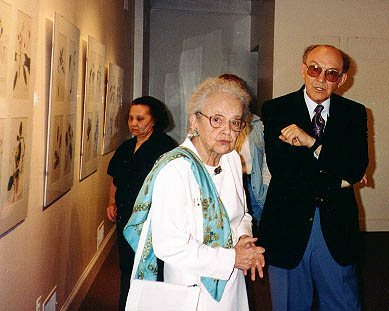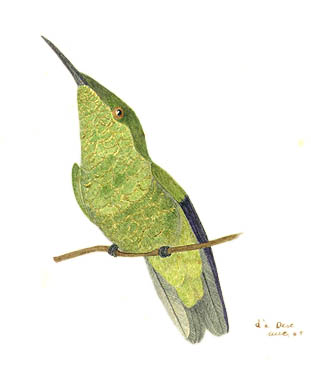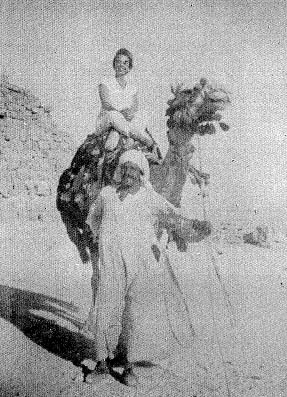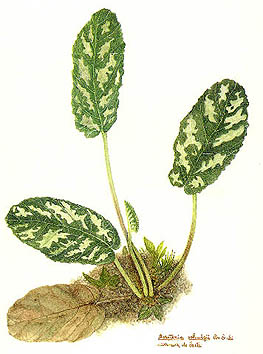And about other botanical illustrators by this time?
I just remember Samuel Salvado.
And Margaret Mee?
By this time, she did not come to Brazil yet.
Dulce: There were those drawers from Manguinhos. Their works are wonderful.
Manguinhos has magnificent scientific illustrations about insects.
Who have drew them?
There were three or four drawers specialized in insects, not in plants.
Dulce: Miss Maria Werneck brought me there because she did a donation of an equipment to draw, called Light Camera. This is a unique piece, beautiful, golden, with historical value for the scientific illustration. They showed us the plates of drawing doing in pen-and-pink, extraordinary works. I was amazed, I have never thought that we had such works in Brazil and no one knows about it. One of those drawers was Professor Raymundo Honório de Castro Silva, Miss Maria Werneck's teacher.
What exactly is this Light Camera?
Dulce: It is instrument that we fit on the table where we will work and it illuminate the drawing we are doing. There is no lamp, it is only mechanical It is a sequence of lens, one reflects in another which reflects the image on the paper. It has a beautiful series of lens.
I would like to know what they did with this equipment.
 And about the exhibitions?
And about the exhibitions? Dulce: There was one at Casa de Rui Barbosa, organized by Pedro Carauta. Then at Botanical Garden, FESP. She participated to many exhibitions in Brazil and abroad like Japan, South Africa, United States, Denmark.
Have you teach drawing?
No, I am completely washout to teach..
Dulce: I do not agree with you.
How could you say that? You have botanical illustrators that consider they had a great influence of you and your works. They consider themselves as your followers like Dulce, for instance, Cristina Miranda, Vânia Aída, Paulo Ormindo, Alexandre Justino...

It is not true, Dulce invented that she was my disciple. I got a bank to sit in the wood because I could not sit on the ground. I brought my bank, my drawing material and Dulce followed me.
Dulce: At FEEMA, they did a homage to Miss Maria Werneck by giving her name to the technical drawing room.
You have had a book published by Salamandra, haven't you?
Yes, "Watercolors, Endangered Vegetal Species". However, I do not have any copy. It is not my fault.
Dulce: You were worried about sending the book to the Botanical Gardens abroad...
There was no interest in sending the book to Botanical Gardens abroad. I have got 25 copies and sent it to them. I have beautiful letters thanking me. I sent them at my own expenses.
I drew something wrong because I have not seen the flowers, I did not know its correct position. When I found out, I felt sick. I wrote a letter to the director of Botanical Garden of Copenhagen telling him that I drew the plant in a wrong position and promised sending later the correct drawing. And I did. I started the correct drawing but I could not finish because no one went to the place where it grows to bring me the plant. Finally, Paulo Ormindo went and finished the drawing to me. He did not want to do this.
"-Where have you seen it, someone starts a drawing and another one finishes it?"
So I answered to him:
"-If no one has never seen it, he will see it now."
So, I sent
I sent it to Botanical Museum of Copenhagen. They sent me a nice letter telling that it will be hung in Herbarium hall where they also have poster reproductions of some Albert Eckhout's painting from Pernambuco, dated of l642.
Dulce: It was not your mistake. When you received the plant, no one explained that it was not like that. The branch was wilted.
It was Norantea brasiliensis. The branch was ascendant and I drew it descendant. I can not remember exactly but I think I only corrected one drawing. I have no memory.
How can you say that you have not memory if you are speaking for more than half a hour, telling us a lot of things?
But I am not telling the main things. Memory is a curious thing. I traveled a lot after coming back from Brasilia. While I was there, I have just done small trips. Long travels I did after coming back to Rio. Some days ago, a friend of mine who has also traveled a lot visited me and you started to remember all those travels. She asked:
" - Have you gone to ....?"
and she forgot the name she wanted to ask me, so I said:
" - I see, you want to know if I went to...".
No matter how hard, I have tried, I took two days to remember. She did not think any more about this and I took two days to remember it was Taj Mahal. Two days to remember Taj Mahal!
Well, well! Forget Taj Mahal, it is sinful. Such beautiful thing.
Some days ago, someone told about Bariloche. I have gone there but I can not remember anything, anything at all. If someone tells me it is similar to Anápolis, I believe. I forgot Bariloche and it is considered very beautiful.
On the other hand, your fabulous trip to see the icebergs, into to North pole, you did not forget. Tell us a little about this travel.
It is impossible to forget North pole. We traveled for 12 days. A friend of mine invited me and she did the itinerary. From London, we went to Bergen, a small fisher town, in Norway. Then we take a ship specially constructed to go to North pole. It boards the Norway coast, town by town. There were many people on board doing studies and were interested in going untilthe parallel 81. So we went and came back. What a beauty. We also went to Pittsbergen, another wonderful place. This kin of travel, no one can forget.
Now, I regret not have took photos.
 Have you visited many other countries?
Have you visited many other countries?
Yes, many!
I went to places where no one likes to go. For example, Egypt, not all people like Egypt. Turkey, I can not say I went because I only know the coast. To Japan, I went alone but I had a friend there.
To Hong Kong, I had the audacity to go alone but during the trip I met two ladies and stayed with there. They though it was a madness coming alone to Hong Kong and they invited me to stay with them.
So I stayed with them and it was very agreeable. I saw many things I wanted to see, alone, while they went shopping. Hong Kong bay is wonderful. To go to Macao, we take a small ship. It is like the Guanabara bay, in Rio de Janeiro.


 Have you had the opportunity to do many
interesting works?
Have you had the opportunity to do many
interesting works? 